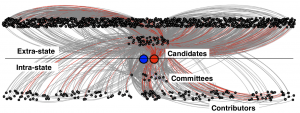 A race, defined to be the set of CANDIDATES competing for the same office, is a much more narrow, locale-relevant use of FEC data. It extracts the subset of all contestants for a race, their contributing committees, and the contributors to these committees. This direct opposition between two candidates is arguably related to forms of “competitive coevolution” arising in other contexts, for example biological virus/host evolution and computational games.
A race, defined to be the set of CANDIDATES competing for the same office, is a much more narrow, locale-relevant use of FEC data. It extracts the subset of all contestants for a race, their contributing committees, and the contributors to these committees. This direct opposition between two candidates is arguably related to forms of “competitive coevolution” arising in other contexts, for example biological virus/host evolution and computational games.
In experiments below, we focus on a subset we will call Races84: the 84 Senate and House races from the five states CA, MN, MA, MT, WI. Initial analysis distinguishes contributions coming to the candidates from the same state (as that within which the race is being run) from extra-state committees and contributors.
This figure presents an example from a “typical” race, the California House District 1 race between DOUG LAMALFA(R) and JAMES REED (D). It is typical in that it poses one Democratic candidate against one Republican candidate; 52 of the 84 races are typical in this sense. The two candidates are represented with large nodes in the center, using the same Democrat:Blue::Republican:Red color convention as above. Below the candidates are two strata of node representing intra-California committees (nearer the candidates) and contributors (on the bottom row). Above the candidates are two much larger sets of nodes representing committees (nearer the candidates) and contributors (on the top row) from outside California. In this particular race, there were 25643 contributors and 61 committees associated with either associated La Malfa or Reed, but only the top 1000 contributors are included in this figure. This race ranks 67 out of 84 races in terms of the number of dollars contributed. See the CIR_techReport for other comparisons and details.
